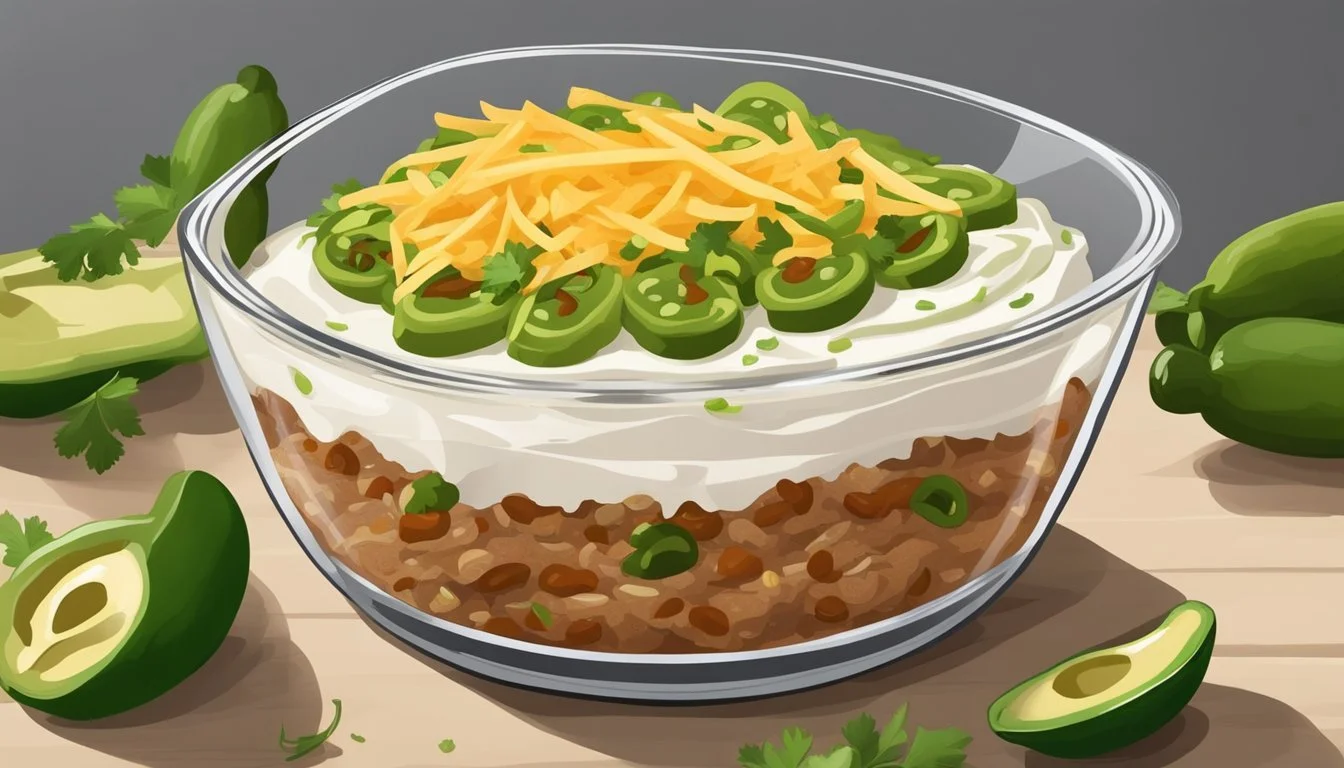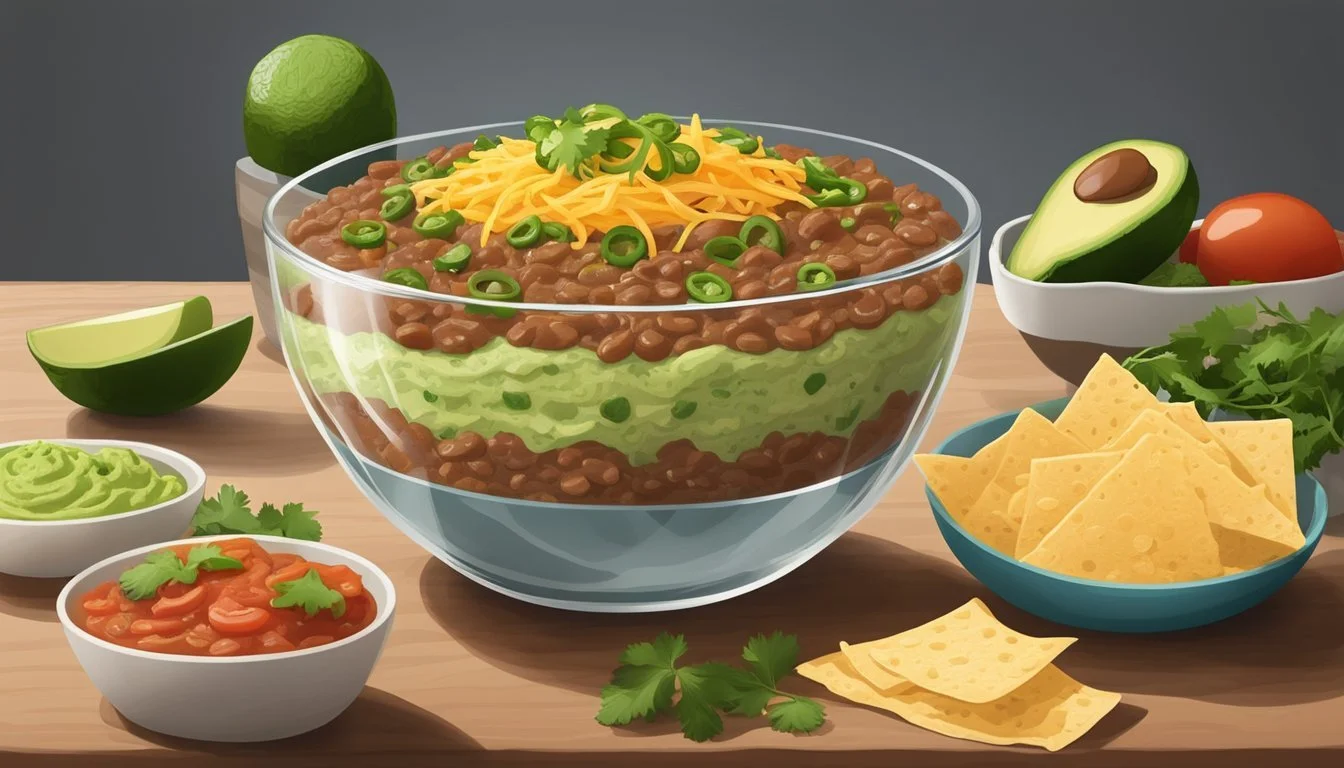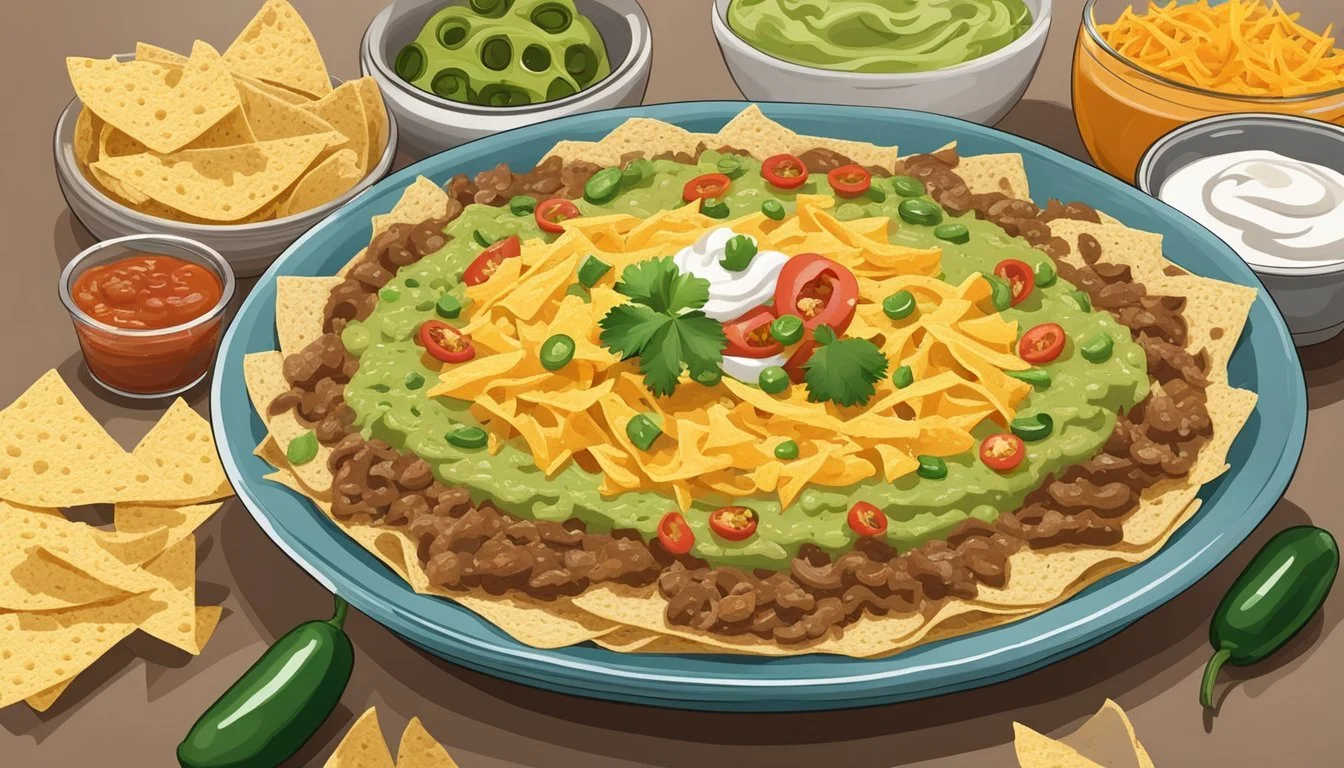How to Make a Texas-Style Layered Bean Dip
Your Ultimate Guide
A Texas-Style Layered Bean Dip is a staple appetizer for any gathering, epitomizing the spirit of communal dining. This dip is especially popular during game day celebrations, such as the Super Bowl, where a hearty and flavorful snack is essential for the full spectator experience. The layered composition not only creates an enticing display of colors and textures but also allows each ingredient to contribute its distinct taste to the overall palate pleasure.
The dip typically begins with a foundation of refried beans mixed with traditional Mexican seasonings or a sprinkle of taco seasoning to set the base with a robust flavor. This is topped with layers of guacamole, sour cream (how long does cream last?) possibly combined with ranch seasoning for added tang, a generous sprinkle of cheese, and a variety of fresh toppings like chopped tomatoes, green onions, and black olives. The result is a harmonious blend of creamy, zesty, and fresh elements, each layer inviting the next dip of a chip.
What sets the Texas-Style dip apart is its emphasis on bold flavors and a hearty texture. While many variations of the layered bean dip exist, it is this particular style’s adherence to Tex-Mex culinary traditions that make it stand out. For instance, some recipes call for a touch of heat with jalapeños or chili powder, pushing the boundaries of a conventional party dip to better represent the larger-than-life Texas ethos.
Understanding Bean Dip Essentials
In crafting a Texas-style layered bean dip, acknowledging its compositional foundations and variant possibilities is crucial. This understanding will serve as a guide to create a flavorful and authentic dish.
Defining Bean Dip
A bean dip typically serves as a hearty base in a layered Texan appetizer and predominantly features refried beans. This element provides a rich, creamy texture and a depth of flavor that is quintessential to the dish's overall profile. Often, refried beans are seasoned with taco or fiesta ranch seasoning, enhancing their savory attributes and ensuring that they contribute to the dip’s robust essence.
Variations of Bean Dip
While traditional Mexican bean dip may employ a singular bean base, the 7 layer dip introduces complexity by sequentially adding various elements. The dip's layers may include, but are not limited to:
Guacamole: A lush layer of mashed avocado seasoned typically with lime juice, salt, and additional herbs.
Sour Cream: Often mixed with taco seasoning or a fiesta ranch packet for an extra tang and zest.
Cheese: Shredded cheese such as cheddar or a Mexican blend adds a melt-in-your-mouth texture and rich taste.
Additional Toppings: Freshly diced tomatoes, green onions, black olives, and sometimes a layer of salsa contribute fresh, crisp, and piquant flavors.
Each layer contributes its own unique flavor and texture, which when combined, culminate in a dip that is versatile and appealing to a wide array of tastes.
Essential Ingredients
The success of a Texas-style layered bean dip depends on the selection of high-quality ingredients that blend together to create a harmonious flavor profile. Each ingredient plays a pivotal role in crafting an authentic and delicious dip experience.
Choosing Beans
Beans form the foundation of the layered dip and are crucial to its texture and taste. One should typically use:
Refried beans: A classic choice for their creamy texture and rich flavor. They serve as the base layer and provide a sturdy canvas for the other ingredients.
Selecting Cheeses
Cheese adds depth and a melt-in-your-mouth sensation to the dip. Choices include:
Cheddar cheese: Offers a sharp, tangy flavor.
Mexican cheese blend: Brings a diverse taste from multiple cheese varieties.
Shredded cheese: Ensures even melting and distribution.
Choose cheeses that are pre-shredded for convenience or shred them freshly for superior melt and flavor.
Cream and Seasonings
Cream and seasonings introduce richness and zest to the dip. Utilize:
1 cup sour cream: For a smooth, tangy cream layer that complements the beans.
Cream cheese: Optional, for added creaminess.
Taco seasoning: Infuses the dip with the quintessential Tex-Mex spices.
The proper blend of cream and seasonings creates a multi-layered flavor that enhances each bite.
Tasty Toppings
Toppings bring color, texture, and freshness to the dip. Top with:
Avocado: Either sliced or in guacamole form for a creamy, rich layer.
Tomatoes: Diced, provide a juicy crunch and a hint of sweetness.
Olives: Sliced black olives add a briny contrast to the creamy layers.
Green onions and cilantro: These fresh ingredients offer a sharp, herby note to cut through the richness.
One should consider the balance of flavors and textures when choosing toppings, aiming for a variety of tastes that complement one another.
Bean Dip Preparation Techniques
Preparing a Texas-style layered bean dip involves thoughtful layering and applying heat to ensure flavors meld beautifully. Attention to detail in these steps is essential for a successful dish.
Layering Strategies
In making a Texas-style layered bean dip, the order of the layers affects both the flavor and the presentation of the dip. Typically, one starts with a seasoned refried bean layer as the base; this can include ingredients like taco seasoning. Following the beans, layers of cheese, sour cream mixed with seasonings, guacamole, chopped green chilies, and additional cheese are added. Each layer should be spread evenly, creating a flat surface before adding the next component.
Base Layer: Begin with refried beans mixed with taco seasoning for a flavor base.
Sour Cream Layer: Combine sour cream with a ranch or fiesta packet and spread over the beans.
Cheese Layer: Generously sprinkle Mexican blend cheese before and/or after heating.
Additional Layers: Top with guacamole, and peppers for extra flavor and texture.
It's important that each layer is distinct, providing a visual appeal when served.
Heating Methods
The choice of heating method can alter the texture and temperature at which the bean dip is best served.
Oven: Preheat to around 350 degrees Fahrenheit. Layer the ingredients in an oven-safe dish and heat until the cheese is melted and bubbly, typically for about 25 minutes. This method is ideal for a hot dip meant to be served immediately.
Microwave: Combine the base ingredients in a microwave-safe bowl and heat for short intervals, stirring between each, until the cheese has melted. This method is quicker and suitable for smaller servings or a softer cheese texture.
Slow Cooker: A slow cooker can be used to keep the dip warm over extended periods, making it ideal for gatherings. Prepare the layers in the slow cooker's pot and set it to a low temperature to heat through and stay warm for guests.
One should ensure that each layer is adequately heated, combining the flavors while maintaining the integrity of individual components.
Cooking Instructions
Creating a Texas-Style Layered Bean Dip requires meticulous layering and precise baking to achieve the perfect fusion of flavors and textures. The following instructions lay out the process from assembly to the baking stage.
Assembling the Dip
One begins by spreading a mixture of refried beans onto the bottom of a casserole dish as the first layer. It's crucial they ensure an even spread to form a solid base. Next, layers of guacamole and a blend of sour cream with taco seasoning follow. Each layer should be applied smoothly so that it covers the preceding one without mixing. Then, toppings of diced tomatoes, green onions, shredded cheese, and sliced black olives are added in that order.
To achieve the best flavor, they cover and let the dip sit in the refrigerator for at least one hour before baking. This chilling time allows the flavors to meld together, enhancing the overall taste of the dish.
Baking the Bean Dip
Before baking, one must preheat their oven to 350°F (175°C) and lightly coat their casserole dish with cooking spray. They will then place the refrigerated dip into the preheated oven. The baking duration is typically around 20-30 minutes or until the cheese is melted and bubbly, indicating that the dip is heated through.
The total time including prep time is approximately 1 hour and 30 minutes, taking into account the necessary chilling duration. They should use an oven-safe baking dish, typically between 8x8 inches and 9x13 inches, depending on the quantity desired. Once the baking is complete, the dip should rest for a few minutes to avoid burning while also ensuring the layers settle, making it easier to scoop and serve.
Serving and Presentation
When presenting the Texas-style layered bean dip, one needs to consider the quantity to serve, appropriate snacks for dipping, and the final decorative touches. Presentation should emphasize the dip's colorful layers, enhancing both visual appeal and taste.
Proper Serving Sizes
The recommended serving size for the Texas-style layered bean dip is approximately 1/2 cup per person. For a gathering of 10 people, one should prepare at least 5 cups of dip, ensuring that there is enough for everyone to enjoy multiple servings. It's essential to provide a spoon or spreader for guests to serve themselves without disrupting the layers.
Accompanying Snacks
Traditionally, tortilla chips are the go-to accompaniment for this dip due to their sturdy nature and complementary flavor. However, one can also offer a variety of dippers such as:
Fritos: For a crunchy, saltier option
Pita chips: Adding a different texture
Crackers: As a lighter alternative
Ensure these snacks are easily accessible and refill as needed to keep the dipping going.
Adding Garnishes
Garnishes not only add to the visual appeal but also enhance the flavor profile of the dish. One might consider sprinkling a mix of garnishes across the top, such as:
Chopped tomatoes
Sliced green onions
Cilantro leaves
For a cheesy and creamy appearance, a final layer of shredded cheese on top right before serving can be quite appealing. Remember, the goal with garnishes is to provide small, bite-sized pieces that complement the dip's texture and taste.
Nutritional Considerations
When making a Texas-style layered bean dip, individuals should be mindful of the nutritional components of the dish, which often includes high-calorie ingredients such as cheese, sour cream, and refried beans. A serving of this appetizer can vary in calories, largely depending on the portion size and specific ingredients used.
Nutritional Breakdown (Approximates per serving):
Calories: 200-300
Fats: 10-15g
Carbohydrates: 18-25g
Protein: 6-9g
Fiber: 3-5g
The dish typically contains a high amount of saturated fat due to the cheese and sour cream. However, the beans provide a good source of fiber and protein, which can be beneficial for digestion and satiety. Taco seasoning, another common ingredient, may add a significant amount of sodium, something to be cognizant of for those monitoring their intake.
It is possible to make the dip healthier by substituting traditional ingredients with low-fat or non-fat versions. For example, using low-fat cheese and sour cream can reduce the total fat content. Also, opting for homemade refried beans can lessen the sodium content, providing better control over the nutrition facts of the final product.
Understanding the nutritional information of each layer can help in making informed decisions that align with one’s health goals or dietary restrictions. As such, they can enjoy this flavorful dish while managing their overall nutrient consumption.
Storage and Leftovers
Maintaining the quality of leftover Texas-style layered bean dip requires proper storage techniques. Here's how to keep the dip fresh and delicious for future enjoyment.
Refrigeration Best Practices
For optimal freshness, leftovers should be stored in an airtight container within two hours of serving. The dip can be refrigerated for up to 48 hours. To prevent the components from becoming soggy, the dip should be covered with a tight seal of plastic wrap or a dedicated container lid. If any fresh toppings such as chopped tomatoes or greens were used, it's best to remove them before storing to preserve the texture of the dip.
Reheating Leftover Dip
If one prefers their bean dip warm, they can reheat it in the **
Frequently Asked Questions
When crafting a Texas-style layered bean dip, one may have questions regarding ingredient substitutions and altering the size of the recipe. The following subsections aim to address these common inquiries with precision and clarity.
Substituting Ingredients
In a Texas-style layered bean dip, ingredients might need to be replaced due to dietary restrictions, availability, or personal preference. One can substitute refried beans with an equal amount of black or pinto beans that have been mashed. For a lighter option, Greek yogurt can replace sour cream, and low-fat cheese can be used instead of full-fat variants. If the traditional guacamole isn't available, mashed avocados with a squeeze of lime juice and a dash of salt can suffice.
For seasoning, if taco seasoning is not on hand, a blend of cumin, chili powder, garlic powder, onion powder, and paprika can create a similar flavor profile. In case of a salsa shortage, diced tomatoes mixed with minced onion, jalapeño, and cilantro can serve as a fresh alternative.
Scaling the Recipe
Altering the size of the recipe to cater to different numbers of guests is straightforward. To enlarge the dip:
Double the quantities for a larger crowd, using a larger dish correspondingly.
Maintain the layer ratios to ensure consistent flavor in every bite.
To create a smaller batch:
Halve the ingredient amounts.
Utilize a smaller serving dish to keep the layer thickness consistent.
It's essential to keep the layers distinct and proportionate regardless of the dish size, for both visual appeal and taste. When scaling, one should also consider the size and depth of the serving dish to ensure consistent layering.
Healthier Alternatives
Informed substitutions can transform a traditional Texas-style layered bean dip into a healthier treat without compromising on taste. By focusing on low-calorie options and incorporating vegan and vegetarian variants, one can create a dip that is both nutritious and flavorful.
Low-Calorie Options
For those watching their calorie intake, choosing low-calorie ingredients is key. One can replace traditional refried beans with fat-free refried beans or even homemade pureed black beans. Additionally, swapping out sour cream for non-fat Greek yogurt adds protein while cutting down on fat. Cheese can be a diet's downfall, so using a reduced-fat cheese or simply less of a full-fat cheese helps control calorie count. For an even more refreshing layer, opt for fresh pico de gallo or salsa rather than calorie-dense sauces.
Vegan and Vegetarian Variants
Vegetarian and vegan diets require special consideration in ensuring the dip is free of animal products. Vegans can substitute sour cream with cashew cream and select vegan cheese options. The creamy layer often using mayonnaise can be exchanged for vegan mayo or a blended silken tofu alternative. Vegetarian options tend to be less restrictive, but still focus on plant-based goodness by utilizing freshly mashed avocados, abundant chopped veggies for extra layers, and lentils as a nutritional cornerstone in place of or alongside beans.








